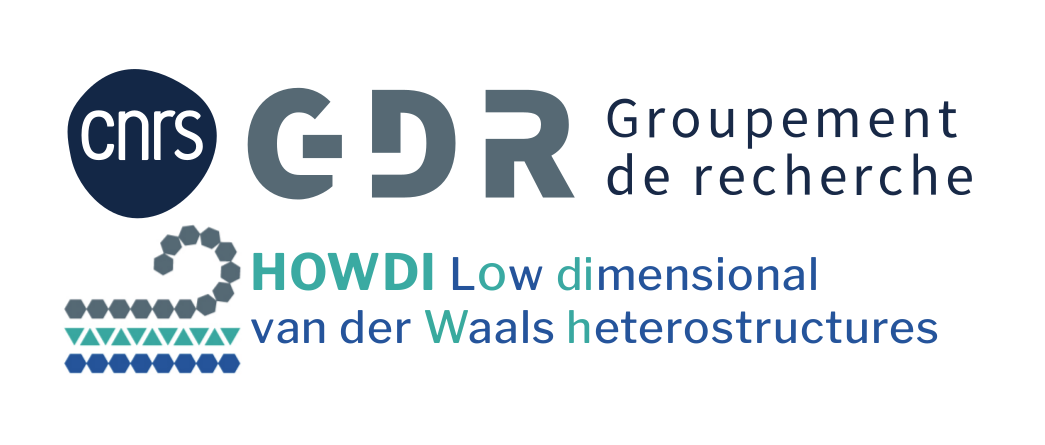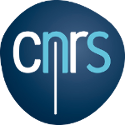GDR
The "HOWDI" research group: Van der Waals hetero-structures of low dimensionality "is both a national research group (GDR 2112) and an international coordination network (IRN" Graphene and co).
A huge scientific proliferation has emerged in recent years around man-made structures created by atomic-scale assembly of 2D materials into structures called van der Waals heterostructures (HvdW). This approach, which makes it possible to shape completely new physical properties by controlling assembly at the atomic scale, but with relatively light tools, inexpensive and accessible to a large number of laboratories, permeates all areas of physics: electronic transport in new regimes ranging from ballistics to saturation regime, from superconductivity to Mott insulators, optical with for example the appearance of topological effects in the excitonic signatures, with the ability to create almost perfect mirrors of thickness atomic, magnetic, thermal with new modes of heat dissipation thanks to the exploitation of near-field infrared modes in the structure… This ease of access and the wealth of new effects discovered explain the extraordinary popularity of this concept. to become a new paradigm in nanoscience.
The ambition of the GDR is to bring together and interact with teams interested in the study of all the physical properties that emerge from these van der Waals assemblies.
The study of van der Waals hetero-structures was born with 2D materials thanks to their greater ease of handling, but the concept was extended to one-dimensional structures (concentric nanotubes of different materials) then to mixed dimensions (for example , 0D inclusions (“quantum dots”) in 2D stacks, or insertion of 0D molecular structures in 1D nanotubes… In each situation, the physical properties born from the electronic coupling at the interfaces between the layers open up countless perspectives.
Beyond the first successes and proofs of concept obtained by “artisanal” manipulation of the constituents of heterostructures, the challenges to master the manufacture of these structures in a reproducible and large-scale manner are immense and the community likely to work on these aspects remains largely to structure. This issue constitutes axis 1 of the new GDR. It is the key to success for any future development of HvdWs. This involves both synthesizing the different materials on a large scale, but also assembling them, if possible in situ and avoiding any pollution. Various approaches are possible covering advanced physical and chemical aspects. Aspects related to the life cycle of these materials, the control of their dissemination and their possible toxicity and ecotoxicity will also be considered. Moreover, the challenges of characterizing the structures obtained are not less. Beyond the structural aspects, the different physical properties are so sensitive to the effects of coupling between layers, that characterization tools specific to each domain will have to be developed (example: electronic mobility, pure exciton phase shift, etc.).
We are organized into four thematic axes covering the different experimental approaches, but we obviously intend to do everything possible to promote exchanges between these approaches. Theoretical aspects are dealt with transversally. We break down this structuring into three axes through aspects of electronic transport and its interfaces (axis 2), optical, excitonic and photonic properties (axis 3) and properties related to spin and electronic correlations (axis 4).
![]() # axis 1: fabrication and advanced characterization of hetero-structures
# axis 1: fabrication and advanced characterization of hetero-structures
![]() # axis 2: electronic transport and its interfaces
# axis 2: electronic transport and its interfaces
![]() # axis 3: optical, excitonic and photonic properties
# axis 3: optical, excitonic and photonic properties
![]() # axis 4: properties related to spin and electronic correlations
# axis 4: properties related to spin and electronic correlations
Nationally, the GDR presents itself as a wall-less research center and brings together more than 80 research teams from CNRS research units, universities or public bodies such as CEA and Onera. In total, several hundred permanent researchers and engineers are involved. Internationally, the partners are internationally renowned scientists from Canada, Belgium, Greece, Spain, Germany and the United Kingdom, who have played, for 10 years, a major role for the development and federation of research on nanotubes, graphene and 2D materials with French teams. Recent partners from Russia, Finland and Brazil have joined the partnership.
At the national scale, the group acts as research centre without wall and gathers more than 80 research teams from CNRS research units, Universities or public organisms such as CEA and Onera. All together, several hundreds of permanent researchers and engineers are involved. At the international scale, partners are scientists of international reputation, from Canada, Belgium, Greece, Spain Germany and United Kingdom, who have played, since 10 years, a major role for developing and federating researches on nanotubes, graphene and 2D materials with the French teams. Recently partners from Russia, Finland and Brazil have joined the partnership.
The objective of the GDR "HOWDI" and GDRI "Graphene and co" is to initiate, sustain and cross-link research activity on graphene, other 2D materials and nanotubes conducted by partner laboratories on prioritized topics.
The federative actions within the GDR aim at promoting exchanges between scientists, sharing knowledge and know-how, facilitating the access to instrumental or technical platforms, initiating cooperative research on hot emerging topics, training young researchers and finally disseminating scientific achievements. The GDR organizes platforms such as thematic or strategic workshops, international conferences and topical schools. The GDR also organizes outreach events towards industrial partners to help disseminating innovative findings, devices and processes obtained in partner labs.
The GDR and GDR-I board members contribute to committees of large conferences such as APS or MRS meetings, the NT and Graphene conference series. It supports the participation of young researchers to these events. Finally, the GDR organizes an annual general meeting gathering the entire community in view of sharing achievements and triggering new collaborative projects.
Comittee
Comittee
Organisation of the GDR n°2112 (HOWDI) and the GDRI (Graphene and co)
Chair : Christophe Voisin
Address : LPENS, CNRS-ENS-SU-Université de Paris (France)
French co-chair : Johann Coraux
Address : Institut Néel, CNRS, Grenoble (France)
French co-chair : Stéphane Berciaud
stephane.berciaud at ipcms.u-strsbg.fr
Institut de Physique et Chimie des Matériaux, Université de Strasbourg
French co-chair and International Chair : Annick Loiseau
Address : LEM, UMR104 CNRS-ONERA, Châtillon (France)
International co-chair : Jean-Christophe Charlier
Address : NAPS, Université Catholique de Louvain, Louvain-la-Neuve (Belgique)
National scientific committee :
Axe 1 : Amandine Andrieux (Onera, Chatillon), Christophe Bichara (Cinam, Marseille), Stéphane Campidelli (CEA, Saclay), Fabrice Oehler (C2N, Palaiseau)
Axe 2 : Jean-François Dayen (IPCMS, Strasbourg), Philippe Dollfus (C2N, Palaiseau), Felicien Schopfer (LME, Paris)
Axe 3 : C. Attacalite (CINAM, Marseille), G. Cassabois (L2C, Montpellier), Cédric Robert (LPCNO, Toulouse), Antoine Reserbat-Plantey (CRHEA, Antibes)
Axe 4 : C. Barreteau (CEA, Saclay), Clément Faugeras (LNCMI, Grenoble), Bruno Dlubak, Marie Blandine Martin, Pierre Seneor (Thales, Orsay)
Communication and Secretary :
HODGES Olga
Web master :
COLIN Yann and VOISIN Christophe

